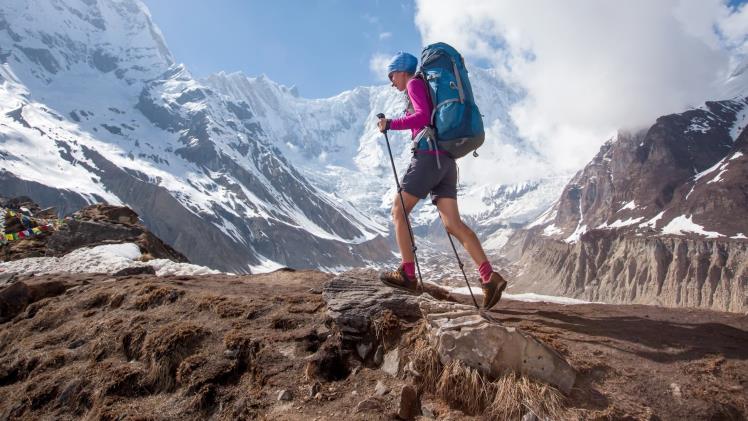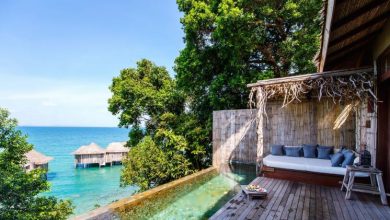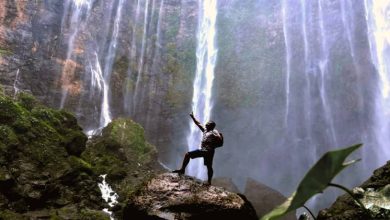The Ultimate Annapurna Circuit Trek with Sherpa A Journey of a Lifetime

It is extremely exciting to trek the Annapurna Circuit, voted as one of the best trekking routes in the world. Annapurna Circuit Trek with Sherpa Guide: The Ultimate Guide This place promises lifelong memories for trekkers looking for challenge and beauty.
Beginning in the lively city of Pokhara, the trek winds through verdant subtropical forests, terraced fields, and idyllic villages of the Gurung and Magar people. Ascending slowly, you will walk through traditional settlements where you can feel the warm hospitality of the local people. The enriching nature of Nepalese culture together with the stunning environment both add variation to the trek whilst providing a relaxed meditative experience. The adventure is as much about the locals as the land. Your Sherpa guide will also be there during the journey; with years of experience and an intimate knowledge of the mountains, they will help you through the circuit, ensuring you’re feeling safe and well.
The Annapurna Circuit is known for its diversity of landscapes, from subtropical forests to alpine meadows and, ultimately, to the rugged terrain along the border with Tibet. Crossing the Thorong La Pass — the highest point on the circuit at 5,416 meters — is one of the most iconic parts of the trek. When you finally achieve this high ascendancy, you will be rewarded with an awe-inspiring panoramic view of snow-capped summits like Annapurna, Dhaulagiri, Machapuchare, and rest, a spectacular vision that will leave you speechless. The feeling of crossing the pass is exhilarating and unforgettable, and your Sherpa will be by your side, encouraging you through this difficult part of the trail.
As you start the descent into the Kali Gandaki Valley, the landscape changes yet again, as the desert-like region of Mustang provides a drastically new view of the Himalayas. The villages here show Tibetan influences — monasteries, prayer flags, and chortens (Buddhist shrines) are scattered throughout the countryside. The trek ends in the village of Jomsom, where trekkers typically fly back to Pokhara, pondering the transformational journey they just accomplished.
Completed with a Sherpa gained from the Annapurna Circuit Trek, it isn’t just about achieving the stop; it’s regarding the journey itself. It’s a moment to ponder, question yourself, and rejoice in the grandeur of Nepal’s nature and culture. If you want an experience that will literally last a lifetime, then look no further than the Annapurna Circuit; you’ll never forget it.
An Overview of Annapurna Circuit Trek
The Annapurna Circuit Trek is a world-famous trekking route that attracts thousands of adventure lovers from all over the world. Nepal – Taking tea-cos-monkeys-are-drunk-in-trees The Everest Base Camp Trek: Nepal Situated in the heart of the Himalayas in Nepal, this popular trek provides an incredible array of landscapes, cultures, and adventures. Ranging approximately 160–230 kilometers, depending on which route you follow, the trek takes you through green forests, charming villages, high-altitude desert, and spectacular mountains. The challenge of the trek is to summit the Thorong La Pass, which stands at an elevation of 5,416 meters (17,769 feet), making it one of the world’s tallest hiking passes. However, it is not only a physical challenge but also immerses one in the traditional culture of the local Gurung, Magar, and Thakali communities. The hike has been considered are a perfect mute of facial, introductory form, and adventure.
Annapurna Region Overview
One of the most beautiful and diverse regions, Annapurna is home to a variety of Nepal’s highest and most magnificent peaks, including Annapurna I, Dhaulagiri, Machapuchare, and many more. With seven famous peaks above 7000m and, the stunning Annapurna range is stretched 55 km (34 mi) where Annapurna peaks are visible all during the trek. Dense subtropical forests, alpine meadows, and arid highlands fill the region which is also home to rich biodiversity including a wide variety of flora and fauna. The Annapurna region is home to several trekking paths, one of the most famous of which is the Annapurna Circuit. Not only is it a trekkers’ paradise, it is also a cultural melting pot, with many ethnic groups living in the area. Buddhism and Hinduism are practiced by local communities here, and their monasteries, temples, and customs offer trekkers rich insights into the area’s spiritual and cultural life. With its diverse terrain ranging from lush valleys to infamously high mountain passes to crystal clear lakes, the Annapurna region has something to offer every type of traveler.
The limit of days you could spend on this trek is up to 24 days however you will be guided by a professional as you are not postgraduate about this trek.
There are numerous reasons why trekkers opt for the Annapurna Circuit Trek. Above all is the unique natural beauty. The hike passes an astonishing variety of landscapes, from subtropical forests to alpine meadows, high deserts,s, and even snow-covered mountain ranges. It is one of the most scenic treks in the world and this different variety of scenery is one of the reasons for it. Also, the Annapurna Circuit is comparatively more moderate than many other high-altitude treks (i.e. Everest Base Camp trek), so more trekkers are able to join. Because the trek runs through many changeless villages, it is also great for those who are after the cultural experience— travelers can meet local people and experience genuine Nepali culture. It is also known for its hospitality, comfortable guesthouses, and teahouses along the route. Most importantly, the trek gives a great sense of accomplishment as trekkers reach the highest point on the circuit, Thorong La Pass at 5,416 meters, a sense of climbing one of the world’s most famous trekking climbs.
Before Your Trek: Important Facts You Should Know
The Annapurna Circuit Trek is a challenge that must be properly prepared for; it takes physical stamina, mental fortitude, and the right gear. Being physically fit is vital in the first place. Although the trek is not overly technical, it features long days and high altitudes, so be sure to prepare your body through monthly exercise regimens such as cardio workouts and strength training, as well as regular hiking. Another important consideration is acclimatization, as altitude sickness can be an issue for trekkers, especially when crossing the Thorong La Pass. To cope with this, allow yourself a few days to acclimatize at points along the trek and hydrate frequently. A point we will emphasize later is whether you have the right trekking gear, including hiking boots, a sleeping bag, layered clothing, a rain jacket, and a daypack. Similarly, import documents like trekking permits and insurance. It is also worth getting a health check-up prior to the trek and bringing the relevant medications for headaches, altitude sickness, and digestive disturbances. Exploring the landscape and challenges that lie ahead will also help you set realistic expectations and navigate the hike with confidence.
How to Choose a Good Sherpa for Your Trek
However, by doing an Annapurna Circuit Trek with a Sherpa you can gain lots of benefits and make your experience 10 times better. Sherpas are very well-acclimatized mountain guides and porters who know the trails, weather patterns, and the subtleties of high-altitude trekking. When selecting the appropriate Sherpa, seek out a qualified and reliable guide organization, ideally one that has been suggested by past trekkers or reputable travel agencies. So a good Sherpa should know the route, interpret it, and communicate it. They can also assist you in the process of acclimatization and dealing with altitude sickness. But there is so much more to them than logistics — Sherpas also provide invaluable insight into the culture, history, and communities along the way, enriching the experience overall. When choosing a Sherpa they need to assess their experience, personality, and if they can handle your trek style. It is also important to have clear expectations regarding rates, responsibilities and services before we set off on the trek. Having a good relationship with your Sherpa, which is positive, strong, and trusting, makes your trek much smoother, safer, and more enjoyable.
Permits and regulations for trekking
Trekking the Annapurna circuit requires trekkers to get certain permits and follow local regulations. It would be the two major permits, the Annapurna Conservation Area Permit (ACAP) and the Trekkers’ Information Management System (TIMS) card. The ACAP protects and maintains the trekking region and the TIMS card assists authorities in tracing trekkers in emergencies. These permits can usually be obtained via authorized trekking companies in Kathmandu or Pokhara, or at local government offices in either town. Permit costs can vary, and they must be carried at all times on your trek. In addition to the above, trekkers should also be aware of the local customs and regulations, such as respecting the environment, the local culture, and the regulations of the villages you pass through. Moreover, as the Annapurna Circuit crosses through different ethnic communities it is essential to observe their customs. Breaking local rules can mean fines or having your trek cut short. As a result, it is important to stay up to date with the most recent rules and regulations before you set off on your next adventure.
When is the Best Time to Trek the Annapurna Circuit?
The optimal conditions for trekking the Annapurna Circuit Trek Itinerary are found during the pre-monsoon (spring) and post-monsoon (fall) periods, from March to May and September to November, respectively. The weather is relatively transitional during these months, ensuring suitable trekking conditions. In spring, blooming rhododendrons and other wildflowers animate the landscape and make for even more stunning vistas. The autumn season provides clear skies and cooler temperatures, making it a favorite amongst trekkers. The best time to trek to Annapurna base camp is during the spring from mid-March to May, and fall from mid-September to November. Both seasons offer the best views of the Annapurna mountain range and comfortable trekking conditions. The other season that is not suitable for trekking is monsoon (June to August) as the area experiences a lot of rain, making the trail slippery and prone to landslides. Winter (December to February) can bring its own challenges as well, with temperatures plunging far below freezing — the higher you go, the colder it gets — and snow blocking the trails. So, although winter hikes can be magical for those wanting solitude, they need more advance planning and care.
Annapurna Circuit Day-by-Day Itinerary
Annapurna Circuit Trek is usually in between 12-21 days, it entirely depends upon your pace and your itinerary. A rough day-by-day breakdown would be:
Day 1: Kathmandu to Pokhara.
Day 2: Drive/Fly to Bhulbhule (Trek starting point from Pokhara)
Day 3: Trek from Bhulbhule to Jagat
Day 4: Trek from Jagat to Dharapani.
Day 5: Trek from Dharapani to Chame.
Day 06: Chame to Pisang Trekking.
Day 7: Pisang to Manang (Acclimatization day).
Day 8: Acclimatization day (explore around Manang areas)
Day 9: Manang to Yak Kharka: 8.4 km, 5-6 hours
Day 10: Trek from Yak Kharka to Thorong Phedi [4500m] 8-9 hrs.
Cross Thorong La Pass (5,416m) and descend to Muktinath (2,713m) — Day 11.
Day 12: Drive from Muktinath to Jomsom.
Jomsom to Pokhara – Day 13: Drive.
Day 14: Return to Kathmandu.
Of course, just about every trekker’s dream is to hike the Annapurna, but this itinerary includes more time to help acclimatize to stay healthy and safe for the trek of a lifetime in the Annapurna.
Annapurna Circuit Highlights
The Annapurna Circuit Trek is one of the most popular trekking destinations in the world. Each area has its unique characteristics, such as the stark transition from subtropical jungle to barren, high-altitude landscapes as trekkers climb into the Himalayas. Beginning from the verdant lower valleys, hikers traverse terraced rice fields, deciduous woodlands, and quaint hamlets such as Ghandruk and Chame, offering windows into local customs and lifestyles.
At its highest point is the Thorong La Pass on the way at an altitude of 5,416 meters. At 17,769 feet it’s the highest point of the circuit, and crossing it offers trekkers sweeping views of some of the world’s tallest peaks, including Annapurna I, Dhaulagiri, and Machapuchare. Also noteworthy is the Kali Gandaki Gorge, the deepest gorge in the world. The route also leads trekkers through the cities of Manang and Mustang, neighborhoods influenced by Tibetan Buddhism and dotted with monasteries, stupas , and prayer flags for a deep sense of spiritual serenity. When you combine these incredible nature and culture aspects, and the warm hospitality of the local people, you can see why the Annapurna circuit is an immersive experience.
Lodging and Meals While Hiking
On the Annapurna Circuit Trek, accommodation is usually in local teahouses. These teahouses are a comfortable spot for trekkers to stop after a day of hiking, often offering shared rooms with twin beds and communal areas where trekkers can unwind and share a meal. The further you trek from the starting point, the more rustic the lodgings may be, but they all provide opportunities to socialize with other trekkers and local inhabitants.
Food on the Annapurna Circuit is mostly local, with a variety of traditional Nepalese dishes available, such as dal bhat (lentil soup and rice), momo (dumplings), and vegetable curries. There have been teahouses where they served decent meals, though food choices at greater elevations remained limited. For a change of flavor, many teahouses serve Western fare like pasta, pizza, and pancakes. We also serve hot drinks, including tea, coffee, and hot chocolate, to keep you warm on cold nights. Overall, while the food is simple, it is nutritious and enough for this trek, replenishing trekkers and keeping them going as they meander through the Himalayas.
Altitude and Acclimatization
Altitude is one of the biggest so-called killers in trekking the Annapurna Circuit, with the trek reaching heights of over 5,000 meters. The air has less oxygen at these altitudes, which can cause altitude sickness without proper acclimatization. Gradual Counteracting and Prevention of Altitude Illness: Acclimatization is the best medicine for acute mountain sickness and is simply giving your body time to adjust to lower levels of oxygen.
On the trek itself, it’s crucial to take the proper amount of slow ascent, and even to specifically take rest days at certain altitudes, especially in places like Manang. According to him, the solution is rest days where a trekker will still have to trek but at an easier pace where the body gets adapted to the surroundings. A good rule of thumb is to gain no more than 300-500 m altitude a day, with a rest day every 3-4 days. (Symptoms of altitude sickness include headaches, dizziness, nausea, and fatigue.) If any of these symptoms develop, it’s vital to descend to a lower altitude immediately.
Hydration and nutrition are also key factors in avoiding altitude sickness. Your Sherpa guide will keep an eye on how you’re feeling, and it’s always smart to heed their advice and take any symptoms seriously. Trekking with a Sherpa guide not only means you’re in safe hands, but also they’ll help make sure you take the necessary precautions while trekking.
Cultural Delving in: Village Experience and Culture
The exposure to local culture is one of the most rewarding aspects of the Annapurna Circuit. As you march through quaint villages like Ghandruk, Chame and Manang, you are embraced by the hospitality of the Gurung, Magar, and Thakali people. With their rich history embedded in the region for centuries, these ethnic communities also introduce an intriguing glimpse of Nepalese life through their customs and traditions.
The villages on the way are alive with centuries of Buddhist and Hindu cultural influences visible in the monasteries, stupas, and prayer flags that dot the trekking path. The region’s Tibetan-influenced villages — most prominently Manang and Mustang — allow for an authentic tasting of the area’s spiritual heritage. (You might even get to visit a local monastery to hear the monks share their prayers and teachings.)
The inhabitants of these villages have a traditional lifestyle that’s closely tied to the land, to farming,g and animal husbandry. Most trekkers find interacting with local people, learning about their day-to-day lives, and helping to prepare traditional food very enjoyable. This cultural immersion is one of the trek’s highlights, adding depth to what would otherwise be just an outdoor recreation. Songs, dances and local customs along the way are also fantastic, an emotional layer that makes the journey unforgettable.
Safety Tips for the Annapurna Circuit
Annapurna Circuit difficulty When trekking the Annapurna Circuit, safety should always come first. Perhaps most critically, safety involves adequate preparation, physical endurance, and the right kit (sturdy trekking boots, warm layers, reliable rucksacks). The weather in high mountains is highly changeable, so be prepared for any condition — snow, rain, and blistering sun.
Acclimatization is also a very important aspect of ensuring safety, as altitude sickness can pose a real danger. The recommended ascent guidelines, rest days and, as always, listening to your body, are a must. Watch for early signs of altitude sickness, like headaches, dizziness, and nausea, and get help if needed. Always stay hydrated and avoid alcohol, and ensure that you’re eating well to maintain energy levels.
So yes, hiring an experienced guide and porter is strongly advised, as they would know how to navigate tricky terrain and be able to handle risks. As every connector knows, in case of emergency, have a communication device (i.e., free option texting) and a rudimentary field first-aid kit at your disposal. Finally, stay safe and preserve the environment by following the trail markers and abiding by local regulations.
Hiking: Get in Shape for the Trek
If you plan to hike Annapurna Circuit, training, and physical conditioning for the trek are essential. The hike includes long hours of walking on either uneven or steep walks and high altitudes that affect physical performance. You should build up cardiovascular endurance with regular workouts, such as hiking or running, or cycling.
Beyond cardio, you should also incorporate strength training, focusing on your legs and core. Squats, lunges, planks, and other body-weight exercises will prepare your muscles for the demands of trekking uphill as well as downhill. Movements that promote flexibility such as yoga can also help with balance and injury prevention.
Practice trekking with a loaded backpack as well, so you know what weight you’ll be carrying during the trek. Hiking on mixed terrain will help you build up the muscle coordination and strength that will be required by this route’s challenges. And finally, do not let your mind go untrained for the trek — mental fortitude is as important as physical fitness in getting to the end of the Annapurna Circuit.
A Brief History of the Hallmarks — Annapurna Circuit
The Annapurna Circuit is a magnificent trek and a rewarding experience, but it is not without its challenges. The most notable challenge is the gauge as the trekkers reach heights above 5,000 meters. At such elevations the air’s oxygen content is low, resulting in fatigue and difficulty breathing, so make sure to acclimatize properly (gradually ascend) as you start your journey. Altitude sickness can also affect even the most seasoned trekkers, meaning it’s even more important to identify symptoms early and take the right action.
The other struggle is the terrain: steep ascents, rocky trails, and narrow ridgelines that make careful navigation a must. It can also be snowing or raining, and later the sun is extremely hot, which makes trekking very uncomfortable. However, as you ascend to higher altitudes, accommodations and food options are fewer, and basic services may not be available, forcing trekkers to be self-sufficient.
The Annapurna Circuit is a satisfying trek, despite these obstacles. With the right preparation, mindset, and an experienced Sherpa by your side, all the hurdles that come along the way can be overcome.
Conclusion: A Lifetime in the Making
Annapurna Circuit Trek is more than just a trek, it touches the soul. From the breathtaking height of the Himalayas to the quaint villages nestled in the valleys, the journey connects you with nature as well as culture on a much deeper level. The struggles on the journey — whether the physical exertion of the trek or the effects of altitude — are all part of the metamorphic experience.
Best time to trek Annapurna Circuit While exploring around each twist and turn on this trek, trekkers not only marvel at the breathtaking landscape of the Annapurna region but also come to understand the strength and simplicity of the local people too. It is the interactions with locals, the warmth of their hospitality, and the cosmological significance of the region that encourage a sense of introspection and personal growth.
But as you reel it all together, whether you stood atop the Thorong La Pass (top) or just shared space with your trekking partners at a mountain teahouse, you realize the Annapurna Circuit Trek is more than the distance between where you started and where you end. It’s a journey that provides clarity, gratitude, and a life-long connection to the Himalayas and its people.




